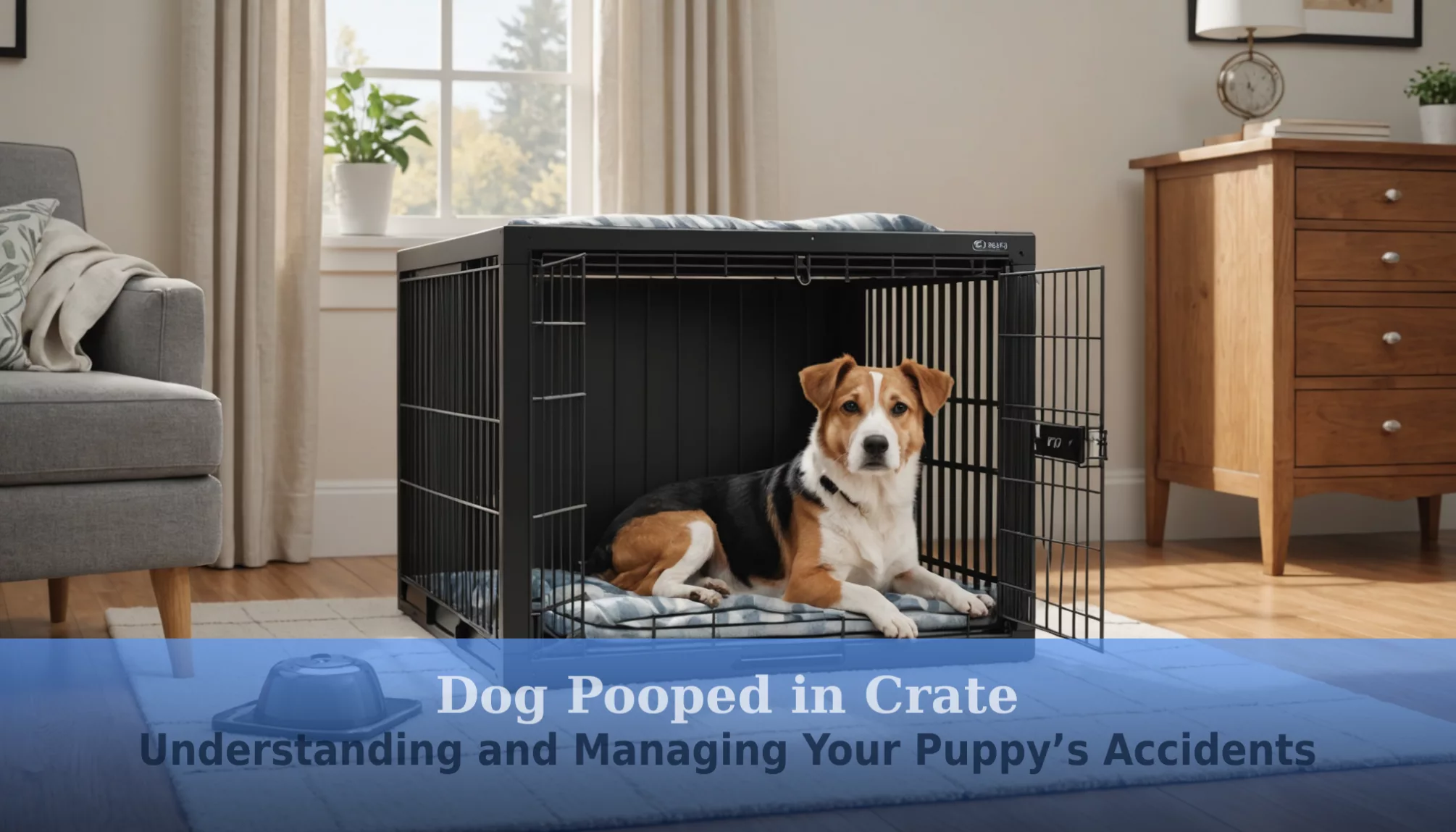Have you ever opened your puppy’s crate and found a surprise that wasn’t exactly what you were hoping for? When a dog pooped in the crate, it can feel frustrating and confusing for any pet owner. Understanding why this happens is essential for keeping your furry friend happy and healthy. Not only can accidents in the crate signal stress or discomfort, but they can also disrupt your dog’s training progress.
This article will dive into the common reasons for crate accidents, the impact of proper training, and how to create a positive environment for your pup. You’ll learn about the importance of crate size, why establishing a consistent routine helps, and tips to manage the situation effectively. Don’t let accidents become a regular occurrence—let’s get to the bottom of this and keep your dog’s crate a clean and comfy space!
Why Is My Puppy Pooping in Their Crate?
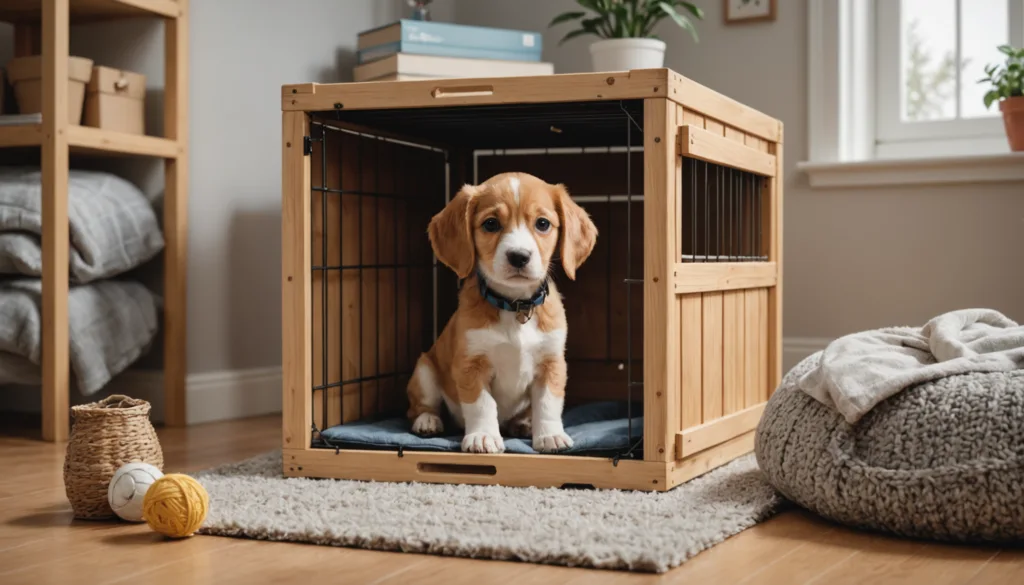
Many puppy owners worry when their puppy poops in the crate. Understanding why this happens can help solve the problem. Common causes include lack of training, stress, and improper crate size.
Common Reasons a Dog May Poop in Their Crate
- Insufficient Training: Puppies need to learn where and when to go potty. Many puppies under six months old are still learning. Crate training helps, but it must be introduced correctly to prevent confusion or stress (Wikipedia: Crate training).
- Anxiety or Stress: Crates can be scary for some dogs, leading to accidents. Stress can come from loud noises, new places, or being away from owners. An anxious dog may not wait for a potty break (Wikipedia: Dog behavior).
- Health Issues: Digestive problems can cause unexpected bowel movements. If your puppy poops in the crate often, it could mean a health problem. Always check with a vet if accidents happen more frequently (Wikipedia: Dog behavior).
Behavioral Factors Influencing Pooping in Their Crate
- Fear of Confinement: If a puppy links the crate with bad experiences, it might not feel safe. This fear can lead to accidents. Proper crate training builds positive feelings about the crate (Wikipedia: Crate training).
- Lack of Routine: Dogs love routine. A steady schedule for feeding, potty breaks, and crate time is crucial. Changes can confuse a puppy, leading to accidents. Establishing a regular schedule can help (Wikipedia: Dog behavior).
- Inadequate Size of Crate: The size of the crate affects a dog’s bathroom habits. If it’s too large, a puppy might use one side as a bathroom. The right size lets the puppy stand, turn around, and lie down comfortably (Wikipedia: Crate training).
The Importance of Crate Size in Preventing Accidents
- Proper Fit: Choose a crate that fits your puppy comfortably. If the crate is too big, the puppy might use it as a bathroom. Measure your puppy and select the right size to prevent accidents.
- Promoting Natural Instincts: Puppies want to keep their sleeping area clean. A well-sized crate supports this instinct, encouraging the puppy to wait until outside.
By understanding these reasons and focusing on training, reducing anxiety, and choosing the right crate size, you can help your puppy feel secure and minimize accidents in the crate.
The Impact of Crate Training on Dog Poop Behavior
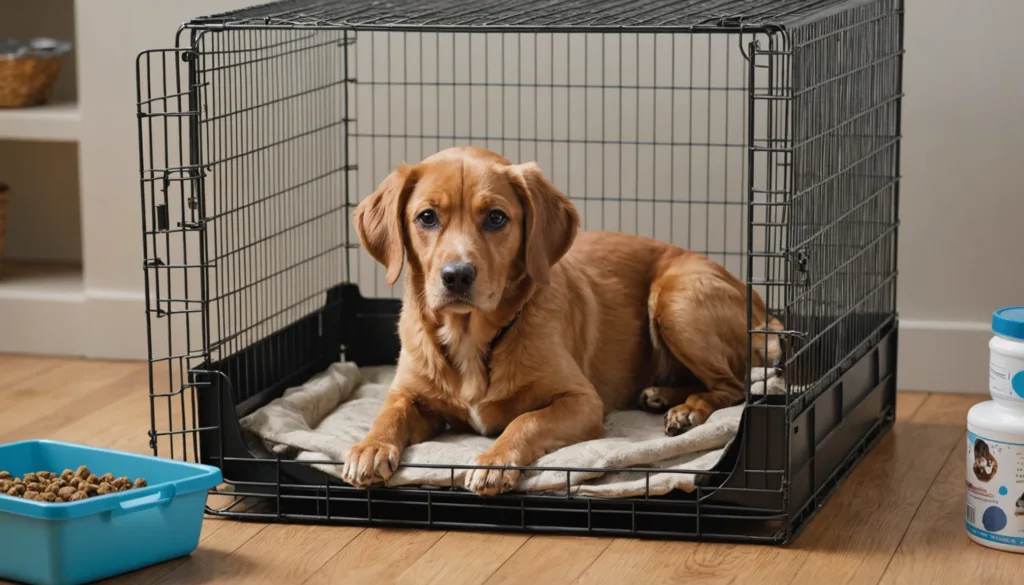
Crate training helps dogs feel safe and learn bathroom habits. When a dog poops in their crate, it can frustrate owners. Understanding crate training’s impact on dog poop behavior can help prevent these issues.
How Proper Training Can Reduce Crate Accidents
Effective crate training can minimize accidents like pooping in the crate. Key elements include:
- Appropriate Crate Size: The crate should be just big enough for the dog to stand, turn around, and lie down comfortably. A crate that’s too large may encourage using one side as a bathroom. A well-sized crate encourages holding bathroom needs until outside.
- Positive Associations: Using positive reinforcement, like treats and praise, when the dog enters the crate willingly and stays calm, helps them see the crate as a safe space.
- Frequent Potty Breaks: Puppies and young dogs need frequent breaks because of small bladders. Regularly taking them outside helps set a routine and lowers accident risks in the crate.
These techniques can teach dogs to avoid soiling their crate, reducing accidents overall.
The Connection Between Stress and Pooping in Their Crate
Stress can cause dogs to poop in their crates. Reasons include:
- Improper Crate Size: A small crate can make dogs anxious, leading to accidents. Dogs need enough room to feel safe.
- Environmental Factors: Loud noises, new places, or being alone for too long can stress dogs out, increasing accident chances in the crate.
- Lack of Positive Experiences: Negative crate experiences, like long confinement or harsh training, may link the crate with stress. Creating positive experiences can ease this anxiety.
Understanding stress’s role in crate accidents can help create a calm environment, leading to better potty behavior.
Establishing a Routine to Prevent Dog Poop Accidents
Consistent bathroom routines prevent accidents. Dogs thrive on routine, helping them know when and where to go. Tips include:
- Regular Feeding Schedule: Feed dogs at the same times daily to help regulate bathroom habits, as they usually need to go shortly after eating.
- Frequent Bathroom Breaks: Take dogs outside regularly, especially after eating, drinking, or waking up, to teach them the right time and place to go.
- Positive Reinforcement: Rewarding dogs with treats or praise for going outside encourages them to avoid using the crate as a bathroom.
Establishing a routine helps dogs learn their schedule, leading to fewer accidents and a happier home. By consistently following a routine, dogs can better understand when it’s time to eat, play, and go outside for their bathroom breaks. This predictability not only reduces anxiety for your furry friend but also strengthens the bond between you and your pet. To assist dog owners in maintaining this routine, a daily puppy care schedule printable can be a handy tool, allowing you to track feeding times, walks, and training sessions effectively.
Understanding Dog Poop and Health Considerations

What Dog Poop Reveals About Health
Dog poop can share important clues about your dog’s health. Healthy poop is firm, moist, and chocolate-brown. Changes in poop, like becoming watery or changing color, might point to health issues. For example, yellow or black feces could suggest liver problems. Blood in the stool is a serious sign that needs quick attention from a vet.
- Healthy Poop Traits:
- Firm and moist
- Chocolate-brown color
- Warning Signs:
- Watery or hard texture
- Colors like grey, yellow, or black
- Blood presence
Monitoring your dog’s poop helps catch potential issues early. If you notice concerning changes, consult a vet to check for problems like infections or digestive diseases such as canine parvovirus [Wikipedia: Canine parvovirus].
Spotting Digestive Issues in Dogs
Digestive problems in dogs show through several symptoms. Watch for changes in appetite, increased thirst, vomiting, and unusual feces. These can indicate infections or dietary problems.
- Common Digestive Symptoms:
- Appetite changes
- Excessive thirst
- Vomiting
- Unusual feces
When you see these symptoms, testing fecal samples may be necessary. Severe lethargy, bloody diarrhea, or dehydration signs need urgent vet care. Regular monitoring of your dog’s health can catch issues early. Stress or anxiety may also lead to pooping in crates.
Consulting a Vet About Crate Accidents
If your dog often poops in its crate, it might be due to stress, poor crate training, or health issues. Finding the cause is key to solving the problem.
- Possible Causes:
- Stress or anxiety
- Lack of proper crate training
- Health problems
A vet can help uncover the cause and suggest fixes. If behavior changes come with digestive symptoms, getting professional advice is crucial for understanding your dog’s health and behavior.
Paying attention to your dog’s poop and behavior offers insights into their well-being. Persistent issues or signs of distress should be evaluated by a vet to ensure your dog’s health. Regular checks and quick action can prevent serious health problems.
Tips to Stop Your Dog from Pooping in Their Crate
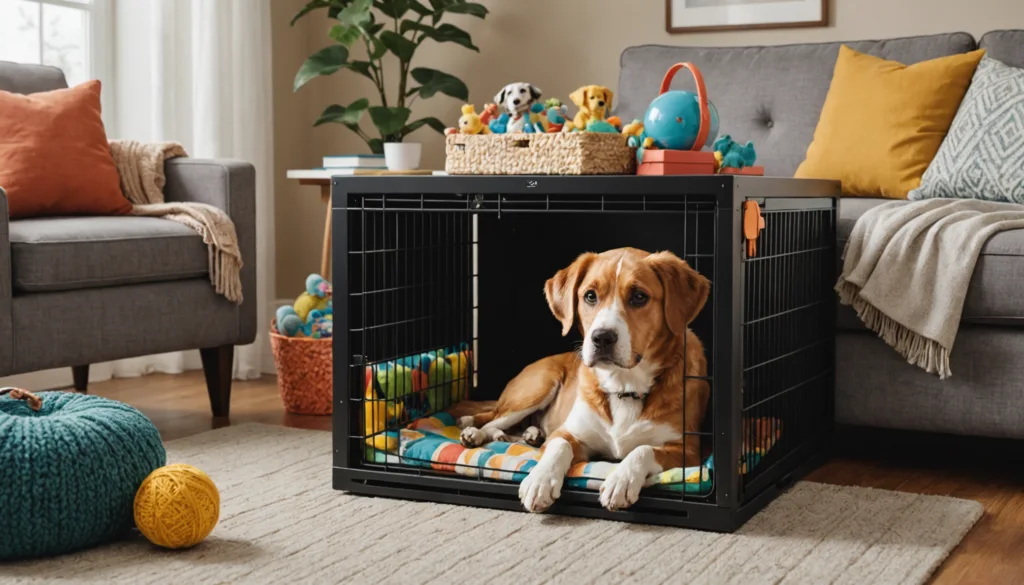
Effective Strategies for Crate Training Your Puppy
Crate training helps your puppy see the crate as a safe space. Follow these strategies to make the process smooth:
- Start Slowly: Let the puppy explore the crate at their own pace. This helps them feel safe and comfortable.
- Use Treats: Encourage them to enter by tossing a treat inside. This makes the crate a positive place.
- Short Time Limits: Begin with short periods in the crate and gradually increase the time. This prevents anxiety and accidents.
- Create a Routine: Set a regular schedule for potty breaks, taking them out before and after crate time.
These strategies can make crate training a positive experience, reducing the chances of accidents.
Positive Reinforcement Techniques to Manage Behavior
Using positive reinforcement encourages good behavior in your puppy. Here’s how:
- Reward Good Behavior: Praise and give a treat when they go outside. This teaches them that this is the right place to go.
- Avoid Negative Reinforcement: Don’t punish crate accidents. Clean up and focus on reinforcing positive actions.
- Consistent Praise: Use a phrase like “good job” when they eliminate outside. This builds a positive connection.
- Set Up a Reward System: Use a simple chart to track successful potty breaks. It motivates both you and the puppy.
Positive reinforcement fosters trust and reduces the likelihood of crate accidents.
Setting Up the Crate Properly to Minimize Accidents
Proper crate setup is crucial in preventing accidents. Consider these tips:
- Choose the Right Size: The crate should let your puppy stand, turn around, and lie down. If it’s too big, they might use one end as a bathroom.
- Comfortable Bedding: Use soft bedding to make it inviting. Puppies tend to keep their sleeping area clean if it’s cozy.
- Location Matters: Place the crate in a quiet, safe spot. This reduces anxiety and helps them feel secure.
- Limit Time in the Crate: Avoid leaving them in the crate for extended periods. Puppies need regular potty breaks.
A well-set-up crate encourages good behavior and comfort for your puppy.
Dealing with Accidents: How to Handle Dog Poop in the Crate
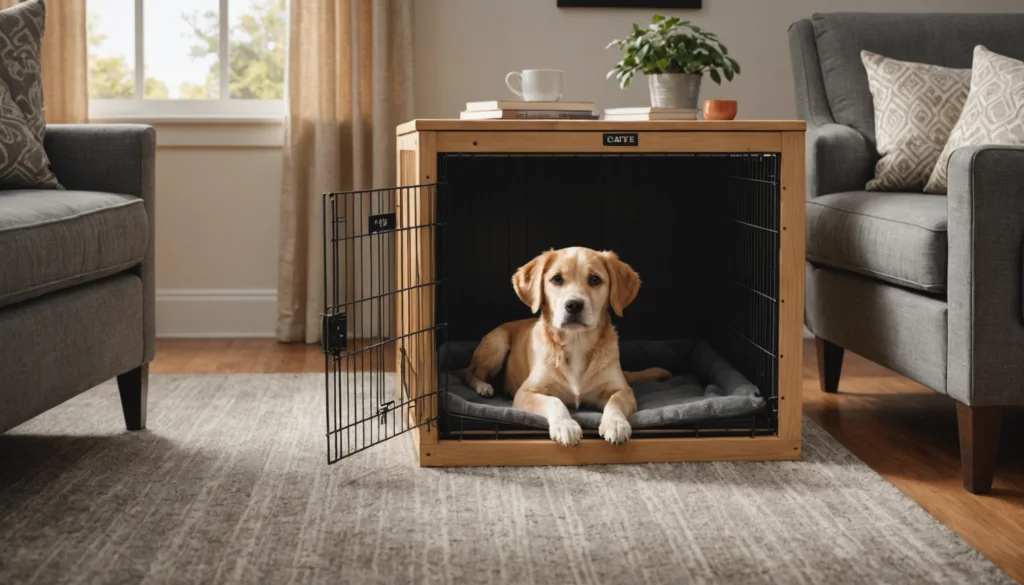
Cleaning and Sanitizing the Crate After Accidents
When a dog poops in its crate, cleaning it well is very important. It helps remove odors that might cause the dog to repeat the behavior. Follow these steps for effective cleaning:
- Remove the Dog: Take the dog out of the crate to ensure safety while cleaning.
- Take Out Items: Remove bedding, toys, and any other items. Wash these separately if possible.
- Use a Safe Cleaner: Choose a dog-safe enzymatic cleaner. Enzymatic cleaners break down waste effectively, unlike regular soap and water.
- Scrub the Crate: Mix water with the cleaner and scrub the entire crate, especially corners and crevices, to get rid of odors and stains.
- Rinse and Dry: Rinse the crate with clean water and dry it completely. Make sure there are no smells before returning items.
Cleaning the crate regularly not only keeps it hygienic but also teaches the dog that the crate is a pleasant space.
How to Properly Train Your Dog After a Poop Incident
Training a dog after it poops in the crate requires patience. Here are some essential strategies:
- Avoid Punishment: Punishing a dog can cause fear. Instead, use positive reinforcement by praising the dog for eliminating outside the crate.
- Create a Routine: Set a consistent schedule for feeding and bathroom breaks. Dogs should go out often, especially after meals and before crate time. This helps them learn when to eliminate.
- Make the Crate Positive: Use treats and toys to make the crate inviting. The dog should feel safe and comfortable in the crate to reduce accidents.
By using positive methods and a predictable schedule, you can teach your dog proper elimination habits.
Maintaining a Positive Environment Post-Accident
After a crate accident, it is important to keep a supportive environment. Here are some ways to do this:
- Stay Calm: Understand that accidents can happen due to stress or health issues. A calm demeanor reassures the dog that it is safe.
- Set Up the Crate Comfortably: Ensure the crate is the right size and has comfortable bedding. A crate that is too large might lead the dog to use one side as a bathroom. The crate should be snug but allow the dog to lie down comfortably.
- Provide Security: Help the dog feel secure by spending time near the crate. Gradually increase the time the dog spends in it while offering treats or toys. This reduces anxiety and builds positive associations.
A supportive environment after an accident is crucial in reinforcing good behavior and ensuring the dog’s comfort.
Expert Opinions on Dog Behavior and Crate Training
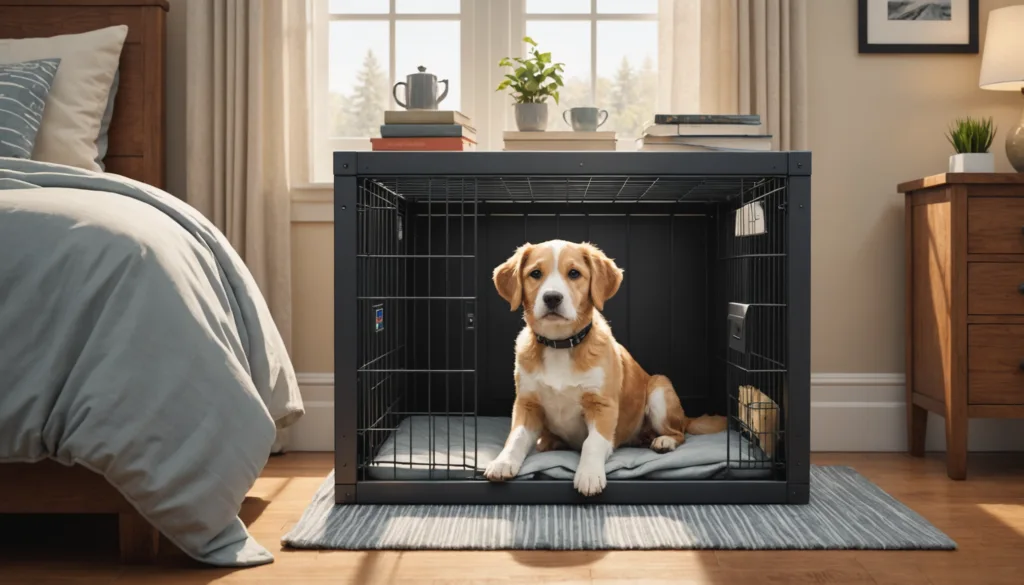
Insights from Veterinarians and Animal Behaviorists
Veterinarians and animal behaviorists help explain why dogs might poop in their crates. They focus on several important areas:
- Gradual Acclimatization: Dogs should be introduced to the crate slowly. This helps them feel safe and secure, which can reduce anxiety. Sudden confinement may cause stress, leading the dog to soil their crate.
- Behavior Monitoring: Watching how a dog acts in the crate is crucial. Consistent stress or anxiety should be addressed by identifying stressors, like loud noises or being left alone for long periods.
- Proper Training Techniques: Positive reinforcement is vital. Rewarding calm entry into the crate helps create positive associations, making the crate a safe space and reducing accidents.
- Crate Size Matters: The crate should be big enough for the dog to stand, turn around, and lie down comfortably, but not so large that it becomes one side for sleeping and another for pooping.
Conclusion
In this article, we explored some important reasons why your dog might be pooping in their crate. Understanding the role of crate size and proper training can make a big difference in preventing accidents. Remember, establishing a routine for bathroom breaks and addressing any stress factors can help your pup feel more comfortable in their space.
By using positive reinforcement techniques and ensuring a clean crate, you can help your dog create positive associations with the crate. If issues persist, don’t hesitate to consult a veterinarian to rule out any health concerns. Remember, with a little patience and care, you can teach your dog to use their crate the right way! Keep learning and exploring ways to make your furry friend’s life even better!
FAQs
1. Why Did My Dog Poop in the Crate?
Dogs might poop in the crate for a few reasons. Puppies often don’t fully understand crate training at first. They can feel anxious or stressed when confined, leading to accidents. If the crate is too big, dogs might use one side as a bathroom and the other for resting.
2. How Can I Stop My Puppy from Pooping in the Crate?
To prevent your puppy from pooping in the crate, use positive reinforcement. Give treats and praise when they eliminate outside. Keep a consistent routine for bathroom breaks. Ensure the crate is the right size to make your dog feel secure.
3. What Should I Do if My Dog Has Frequent Accidents in the Crate?
Frequent accidents can signal stress, health issues, or training problems. Review your crate training methods and adjust as needed. Consult a veterinarian to rule out health issues causing this behavior.
4. Can Stress Cause My Dog to Poop in the Crate?
Yes, stress can cause accidents. Changes in environment, routine, or health problems can make dogs anxious. Identifying stress factors and creating a calm environment can help reduce accidents.
5. What Can My Dog’s Poop Tell Me About Their Health?
The consistency, color, and frequency of your dog’s poop can show their health status. Unusual softness, hardness, or blood may indicate dietary issues or health problems and should prompt a vet visit.

